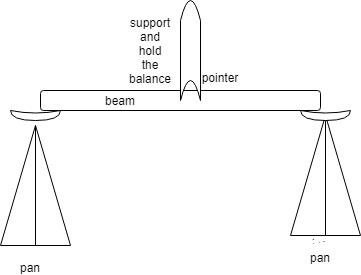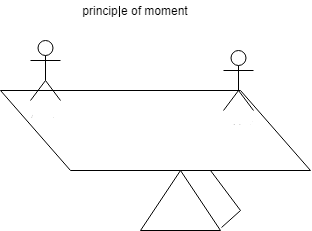
The principle involved in the working of a beam balance is:
A) Principle of moments
B) Principle of inertia
C) Principle of superimposition
D) Principle of velocity
Answer
576.3k+ views
Hint: Phenomenon of balance is based on the moments of the two bodies at both the corners. In short, we can say that when there is the same amount of total clockwise moment = total anticlockwise moment then the body is said to be in a balancing position.
Complete step by step answer:
Step 1:
The definition of a beam balance is that it is a device that is used to determine the mass of a body under gravitation. It consists of a beam generally made up of iron supported at the center by an agate knife-edge resting on a support moving inside a vertical pillar. The beam carries a light pointer which moves over a scale. Two identical pans are suspended at equal distances from the center, at the two ends of the beam.
Step 2:
To understand the working of a beam balance there is a supporting diagram for better understanding.

In figure, there are two pans suspended by a hook and separated by equal distances from the center. There is another hook in the center to support and hold the balance.
The object whose mass has to be measured is placed on one of the pans. Standard weights are placed on the other pan until the metallic beam becomes horizontal and the pointer becomes vertical. The sum of the total of all weight used gives the mass of the object.
Hence the above statement clearly follows the principle of the moment. So, option A is the correct answer.
Note:
A beam balance works on the principle of moments(stated and proved above) according to which in equilibrium, the anticlockwise moment due to the weight of an object on the left pan of the beam is equal to the clockwise moment due to the standard weights of the right pan of the beam.

The principle of moment states that when a body is balanced, the clockwise moment about a point equals to the total anticlockwise about the same point
Total anticlockwise moment = Total clockwise moment.
Complete step by step answer:
Step 1:
The definition of a beam balance is that it is a device that is used to determine the mass of a body under gravitation. It consists of a beam generally made up of iron supported at the center by an agate knife-edge resting on a support moving inside a vertical pillar. The beam carries a light pointer which moves over a scale. Two identical pans are suspended at equal distances from the center, at the two ends of the beam.
Step 2:
To understand the working of a beam balance there is a supporting diagram for better understanding.

In figure, there are two pans suspended by a hook and separated by equal distances from the center. There is another hook in the center to support and hold the balance.
The object whose mass has to be measured is placed on one of the pans. Standard weights are placed on the other pan until the metallic beam becomes horizontal and the pointer becomes vertical. The sum of the total of all weight used gives the mass of the object.
Hence the above statement clearly follows the principle of the moment. So, option A is the correct answer.
Note:
A beam balance works on the principle of moments(stated and proved above) according to which in equilibrium, the anticlockwise moment due to the weight of an object on the left pan of the beam is equal to the clockwise moment due to the standard weights of the right pan of the beam.

The principle of moment states that when a body is balanced, the clockwise moment about a point equals to the total anticlockwise about the same point
Total anticlockwise moment = Total clockwise moment.
Recently Updated Pages
Why are manures considered better than fertilizers class 11 biology CBSE

Find the coordinates of the midpoint of the line segment class 11 maths CBSE

Distinguish between static friction limiting friction class 11 physics CBSE

The Chairman of the constituent Assembly was A Jawaharlal class 11 social science CBSE

The first National Commission on Labour NCL submitted class 11 social science CBSE

Number of all subshell of n + l 7 is A 4 B 5 C 6 D class 11 chemistry CBSE

Trending doubts
Differentiate between an exothermic and an endothermic class 11 chemistry CBSE

10 examples of friction in our daily life

One Metric ton is equal to kg A 10000 B 1000 C 100 class 11 physics CBSE

Difference Between Prokaryotic Cells and Eukaryotic Cells

State the laws of reflection of light

Explain zero factorial class 11 maths CBSE




